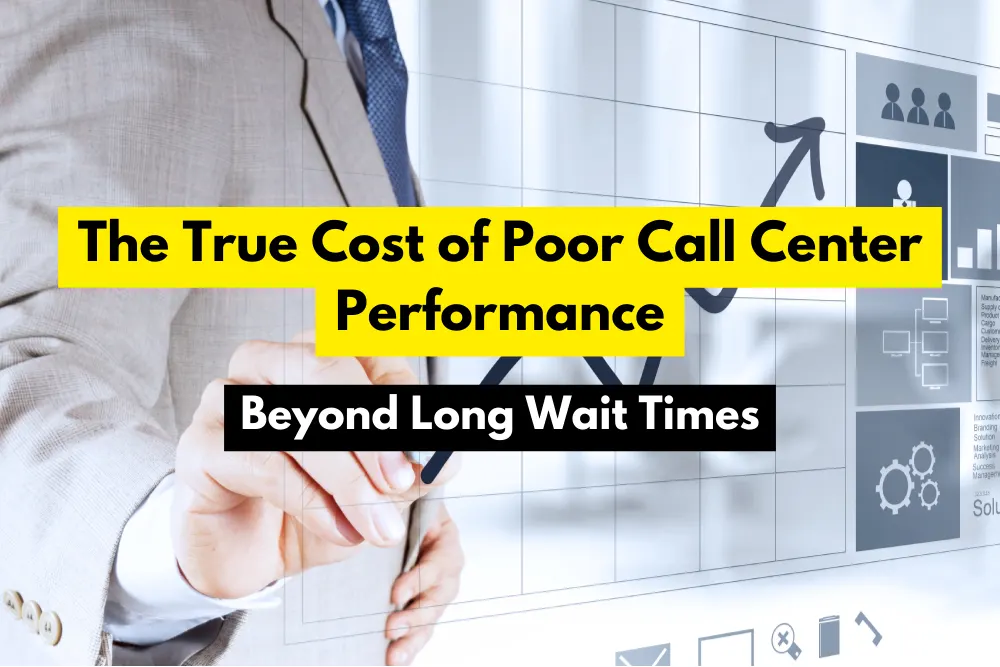The True Cost of Poor Call Center Performance: Beyond Long Wait Times

Call centers are the backbone of customer service, shaping a customer’s perception of your brand. But what happens when call center performance suffers? The consequences go far beyond long wait times and frustrated callers. This article explores the hidden expenses of poor call center performance (The True Cost of Poor Call Center Performance) and offers solutions to optimize your operations.
Identifying Poor Call Center Performance
Effective call centers are measured by key metrics like average wait time, call abandonment rate, and customer satisfaction score. When these metrics fall below expectations, it signifies inefficiencies that cost your business.
The Financial Toll
Poor call center performance directly impacts your bottom line. Increased call volume, longer resolutions due to unresolved issues, and escalated complaints lead to higher operational expenses. But that’s not all. Dissatisfied customers are more likely to churn, leading to lost revenue opportunities.
Beyond the Numbers: Human Resource Costs
High agent turnover, often called the “revolving door” effect, is a major cost associated with poor call center performance. Constant onboarding and training drain resources and leave you with inexperienced agents who struggle to deliver exceptional service.
Technology: A Double-Edged Sword
Outdated call center systems hinder efficiency. Legacy technology lacks features to meet modern customer demands, leading to longer resolution times and frustrated callers. Additionally, a lack of system integration creates fragmented data and disjointed experiences.
Regulatory and Compliance Risks
Failing to comply with data privacy and security regulations can result in hefty fines and legal action. Mishandling sensitive information exposes your business to financial liabilities and erodes customer trust, impacting your reputation.
The Ripple Effect: How It Impacts Your Entire Business
Poor call center performance isn’t isolated. Overloaded customer service teams strain other departments like marketing, sales, and product development. Furthermore, you risk falling behind competitors who prioritize customer experience.
Strategies for Call Center Success
Investing in employee training and development programs empowers agents and reduces turnover. Upgrading to integrated call center technology with automation tools streamlines processes. Proactive measures like prioritizing compliance and data security mitigate risks and safeguard your brand.
Real-World Examples: Case Studies
Many businesses have successfully addressed poor call center performance. By implementing tailored strategies and leveraging technology, they’ve achieved higher customer satisfaction and operational efficiency. These success stories serve as valuable blueprints for overcoming similar challenges.
Conclusion: The True Cost of Subpar Customer Service
The hidden expenses of poor call center performance extend far beyond operational inefficiencies. From financial burdens to regulatory risks and reputational damage, businesses pay a hefty price for subpar customer service. By acknowledging these costs and taking proactive steps to improve call center performance, you can safeguard your bottom line and cultivate long-term success.
FAQs
- How to Measure Performance: Track key performance indicators (KPIs) like average wait time, first call resolution rate, and customer satisfaction score.
- Employee Morale Matters: Satisfied and engaged agents deliver exceptional service, leading to higher satisfaction rates and lower turnover.
- Balancing Compliance and Efficiency: Robust compliance protocols alongside technology solutions that prioritize both security and efficiency are crucial.
By optimizing your call center performance, you can create a positive customer experience that strengthens your brand and drives business growth.